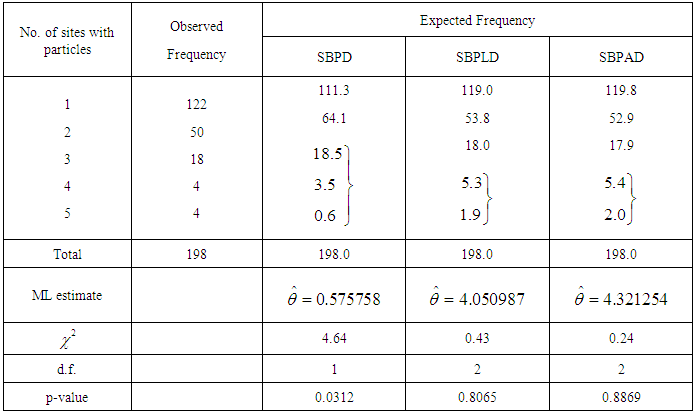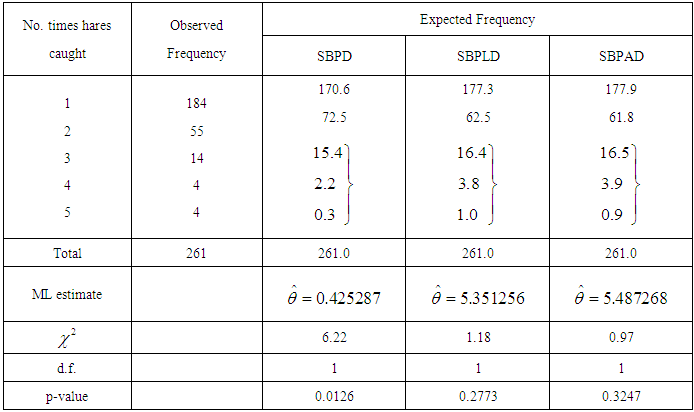-
Paper Information
- Next Paper
- Paper Submission
-
Journal Information
- About This Journal
- Editorial Board
- Current Issue
- Archive
- Author Guidelines
- Contact Us
International Journal of Statistics and Applications
p-ISSN: 2168-5193 e-ISSN: 2168-5215
2017; 7(6): 289-297
doi:10.5923/j.statistics.20170706.03

Size-Biased Poisson-Akash Distribution and Its Applications
Rama Shanker
Department of Statistics, College of Science, Eritrea Institute of Technology, Asmara, Eritrea
Correspondence to: Rama Shanker, Department of Statistics, College of Science, Eritrea Institute of Technology, Asmara, Eritrea.
| Email: |  |
Copyright © 2017 Scientific & Academic Publishing. All Rights Reserved.
This work is licensed under the Creative Commons Attribution International License (CC BY).
http://creativecommons.org/licenses/by/4.0/

A size-biased Poisson-Akash distribution (SBPAD) has been proposed by size-biasing the Poisson-Akash distribution (PAD) of Shanker (2017), a Poisson mixture of Akash distribution introduced by Shanker (2015). The first four moments about origin and moments about mean have been obtained and hence expressions for coefficient of variation (C.V.), skewness, kurtosis and index of dispersion have been given. The estimation of its parameter has been discussed using the method of moments and the method of maximum likelihood estimation. Two examples of observed real datasets have been presented to test the goodness of fit of SBPAD over size-biased Poisson distribution (SBPD) and size-biased Poisson-Lindley distribution (SBPLD).
Keywords: Size-biased distribution, Poisson-Akash distribution, Moments and moments based measures, Estimation of parameter, Goodness of fit
Cite this paper: Rama Shanker, Size-Biased Poisson-Akash Distribution and Its Applications, International Journal of Statistics and Applications, Vol. 7 No. 6, 2017, pp. 289-297. doi: 10.5923/j.statistics.20170706.03.
Article Outline
1. Introduction
- Let a random variable
 has probability distribution
has probability distribution  . If sample units are weighted or selected with probability proportional to
. If sample units are weighted or selected with probability proportional to  , then the corresponding size-biased distribution of order
, then the corresponding size-biased distribution of order  is given by its probability mass function (pmf)
is given by its probability mass function (pmf) | (1.1) |
 . When
. When  , the distribution is known as simple size-biased distribution and is applicable for size-biased sampling and for
, the distribution is known as simple size-biased distribution and is applicable for size-biased sampling and for  , the distribution is known as area-biased distribution and is applicable for area-biased sampling. In many statistical sampling situations care must be taken so that one does not inadvertently sample from size-biased distribution in place of the one intended.Size-biased distributions are a particular case of weighted distributions which arise naturally in practice when observations from a sample are recorded with probability proportional to some measure of unit size. In field applications, size-biased distributions can arise either because individuals are sampled with unequal probability by design or because of unequal detection probability. Size-biased distributions come into play when organisms occur in groups, and group size influences the probability of detection. Fisher (1934) firstly introduced these distributions to model ascertainment biases which were later formalized by Rao (1965) in a unifying theory for problems where the observations fall in non-experimental, non-replicated and non-random categories. Size-biased distributions have applications in environmental science, econometrics, social science, biomedical science, human demography, ecology, geology, forestry etc. Further, size-biasing occurs in many unexpected context such as statistical estimation, renewal theory, infinite divisibility of distributions and number theory. Van Duesen (1986) has detailed study about the applications of size-biased distributions for fitting distributions of diameter at breast height (DBH) data arising from horizontal point sampling (HPS). Later, Lappi and Bailey (1987) have applied size-biased distributions to analyze HPS diameter increment data. The applications of size-biased distributions to the analysis of data relating to human population and ecology can be found in Patil and Rao (1977, 1978). A number of research have been done relating to size-biased distributions and their applications in different fields of knowledge by different researchers including Scheaffer (1972), Patil and Ord (1976), Singh and Maddala (1976), Patil (1981), McDonald (1984), Gove (2000, 2003), Correa and Wolfson (2007), Drummer and McDonald (1987), Ducey (2009), Alavi and Chinipardaz (2009), Ducey and Gove (2015), are some among others.Shanker (2015) introduced one parameter Akash distribution having probability density function (pdf) and cumulative distribution function (cdf)
, the distribution is known as area-biased distribution and is applicable for area-biased sampling. In many statistical sampling situations care must be taken so that one does not inadvertently sample from size-biased distribution in place of the one intended.Size-biased distributions are a particular case of weighted distributions which arise naturally in practice when observations from a sample are recorded with probability proportional to some measure of unit size. In field applications, size-biased distributions can arise either because individuals are sampled with unequal probability by design or because of unequal detection probability. Size-biased distributions come into play when organisms occur in groups, and group size influences the probability of detection. Fisher (1934) firstly introduced these distributions to model ascertainment biases which were later formalized by Rao (1965) in a unifying theory for problems where the observations fall in non-experimental, non-replicated and non-random categories. Size-biased distributions have applications in environmental science, econometrics, social science, biomedical science, human demography, ecology, geology, forestry etc. Further, size-biasing occurs in many unexpected context such as statistical estimation, renewal theory, infinite divisibility of distributions and number theory. Van Duesen (1986) has detailed study about the applications of size-biased distributions for fitting distributions of diameter at breast height (DBH) data arising from horizontal point sampling (HPS). Later, Lappi and Bailey (1987) have applied size-biased distributions to analyze HPS diameter increment data. The applications of size-biased distributions to the analysis of data relating to human population and ecology can be found in Patil and Rao (1977, 1978). A number of research have been done relating to size-biased distributions and their applications in different fields of knowledge by different researchers including Scheaffer (1972), Patil and Ord (1976), Singh and Maddala (1976), Patil (1981), McDonald (1984), Gove (2000, 2003), Correa and Wolfson (2007), Drummer and McDonald (1987), Ducey (2009), Alavi and Chinipardaz (2009), Ducey and Gove (2015), are some among others.Shanker (2015) introduced one parameter Akash distribution having probability density function (pdf) and cumulative distribution function (cdf) | (1.2) |
 | (1.3) |
 of the Poisson distribution to follow Akash distribution (1.2), Shanker (2017) introduced Poisson-Akash distribution (PAD), a Poisson mixture of Akash distribution, having pmf
of the Poisson distribution to follow Akash distribution (1.2), Shanker (2017) introduced Poisson-Akash distribution (PAD), a Poisson mixture of Akash distribution, having pmf | (1.4) |
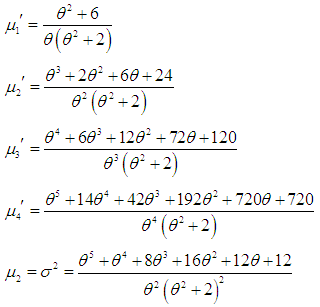
2. Size-Biased Poisson-Akash Distribution
- Using (1.1) and (1.4) and the expression for the mean of PAD, the size-biased Poisson-Akash distribution (SBPAD) with parameter
 can be defined by its pmf
can be defined by its pmf | (2.1) |
 | (2.2) |
 follows size-biased Akash distribution (SBAD) with pdf
follows size-biased Akash distribution (SBAD) with pdf | (2.3) |
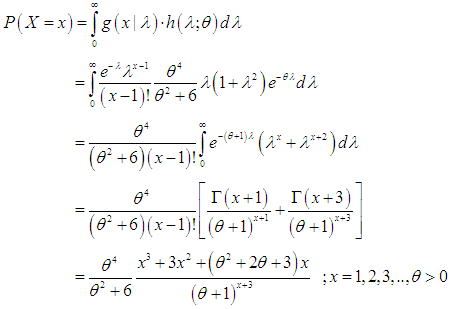 | (2.4) |
 is a deceasing function of
is a deceasing function of  is log-concave. Therefore, SBPAD is unimodal, has an increasing failure rate (IFR), and hence increasing failure rate average (IFRA). It is new better than used in expectation (NBUE) and has decreasing mean residual life (DMRL). The definitions, concepts and interrelationship between these aging concepts have been discussed in Barlow and Proschan (1981).The graphs of the pmf of SBPAD (2.1) for varying values of the parameter
is log-concave. Therefore, SBPAD is unimodal, has an increasing failure rate (IFR), and hence increasing failure rate average (IFRA). It is new better than used in expectation (NBUE) and has decreasing mean residual life (DMRL). The definitions, concepts and interrelationship between these aging concepts have been discussed in Barlow and Proschan (1981).The graphs of the pmf of SBPAD (2.1) for varying values of the parameter  have been drawn in figure 1. The graphs have been shown for both starting from
have been drawn in figure 1. The graphs have been shown for both starting from  and
and  to see the difference in the nature. The graphs starting from
to see the difference in the nature. The graphs starting from  are positively biased whereas graphs starting from
are positively biased whereas graphs starting from  are monotonically decreasing except for
are monotonically decreasing except for  .
. | Figure 1. Graphs of pmf of SBPAD for varying values of the parameter θ |
 | (2.5) |
3. Moments
- Using (2.4), the rth factorial moment about origin of the SBPAD (2.1) can be obtained as
 Taking
Taking  , we get
, we get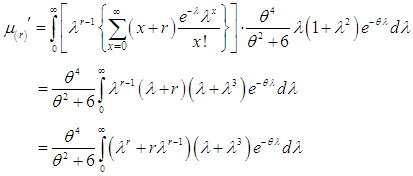 Using gamma integral and a little algebraic simplification, the rth factorial moment about origin of SBPAD (2.1) can be obtained as
Using gamma integral and a little algebraic simplification, the rth factorial moment about origin of SBPAD (2.1) can be obtained as | (3.1) |
 Taking
Taking  in (3.1), the first four factorial moments about origin can be obtained and using the relationship between moments about origin and factorial moments about origin, the first four moments about origin of the SBPAD (2.1) are thus obtained as
in (3.1), the first four factorial moments about origin can be obtained and using the relationship between moments about origin and factorial moments about origin, the first four moments about origin of the SBPAD (2.1) are thus obtained as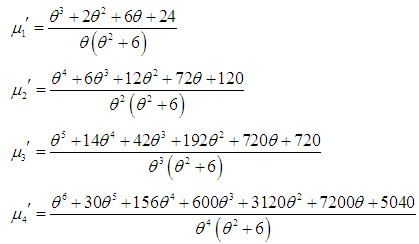 Now, using the relationship between moments about mean and the moments about origin, the moments about mean of the SBPAD (2.1) can be obtained as
Now, using the relationship between moments about mean and the moments about origin, the moments about mean of the SBPAD (2.1) can be obtained as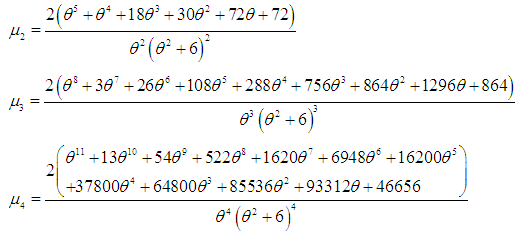 The coefficient of variation
The coefficient of variation  , coefficient of Skewness
, coefficient of Skewness  , coefficient of Kurtosis
, coefficient of Kurtosis  and index of dispersion
and index of dispersion  of the SBPAD (2.1) are thus obtained as
of the SBPAD (2.1) are thus obtained as 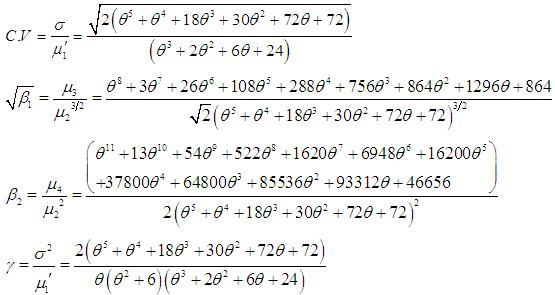 The graphs of coefficient of variation
The graphs of coefficient of variation  , coefficient of Skewness
, coefficient of Skewness  , coefficient of Kurtosis
, coefficient of Kurtosis  and index of dispersion
and index of dispersion  of the SBPAD are shown in figure 2. From fig. 2, it is obvious that C.V and index of dispersion are monotonically decreasing whereas coefficient of skewness and coefficient of kurtosis are monotonically increasing for increasing values of the parameter
of the SBPAD are shown in figure 2. From fig. 2, it is obvious that C.V and index of dispersion are monotonically decreasing whereas coefficient of skewness and coefficient of kurtosis are monotonically increasing for increasing values of the parameter  .
.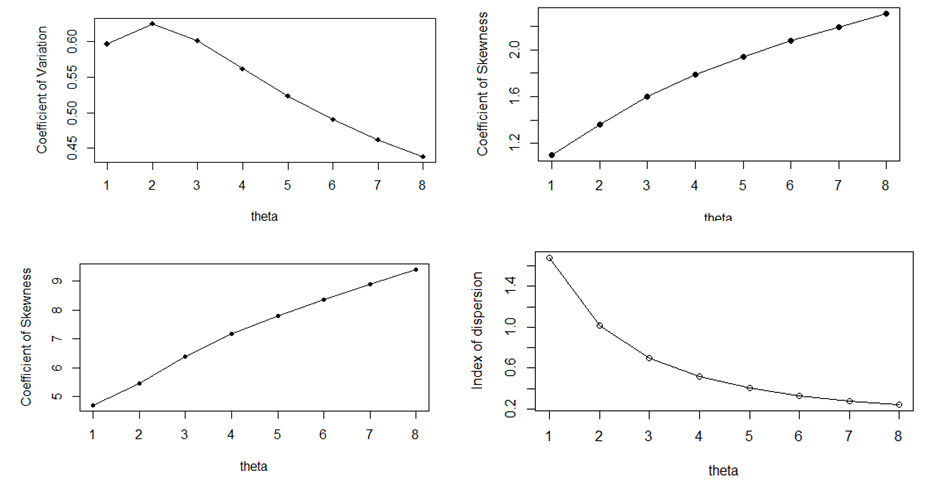 | Figure 2. Graphs of C.V, coefficient of Skewness, coefficient of Kurtosis and index of dispersion of the SBPAD for varying values of the parameter θ |
 , equi-dispersed
, equi-dispersed  and under-dispersed for
and under-dispersed for  . It should be noted that SBPLD is over-dispersed
. It should be noted that SBPLD is over-dispersed  , equi-dispersed
, equi-dispersed  and under-dispersed for
and under-dispersed for  .
.4. Estimation of Parameter
- 4.1. Method of Moment Estimate (MOME): Equating the population mean to the corresponding sample mean, the method of moment estimate (MOME)
 of
of  of SBPAD (2.1) is the solution of the following cubic equation in
of SBPAD (2.1) is the solution of the following cubic equation in 
 , where
, where  is the sample mean.4.2. Maximum Likelihood Estimate (MLE): Let
is the sample mean.4.2. Maximum Likelihood Estimate (MLE): Let  be a random sample of size n from the SBPAD (2.1) and let
be a random sample of size n from the SBPAD (2.1) and let  be the observed frequency in the sample corresponding to
be the observed frequency in the sample corresponding to  such that
such that  , where
, where  is the largest observed value having non-zero frequency. The likelihood function
is the largest observed value having non-zero frequency. The likelihood function  of the SBPAD (2.1) is given by
of the SBPAD (2.1) is given by The log likelihood function can be obtained as
The log likelihood function can be obtained as The first derivative of the log likelihood function is thus given by
The first derivative of the log likelihood function is thus given by  where
where  is the sample mean.The maximum likelihood estimate (MLE),
is the sample mean.The maximum likelihood estimate (MLE),  of
of  of SBPAD (2.1) is the solution of the equation
of SBPAD (2.1) is the solution of the equation  and is given by the solution of the following non-linear equation
and is given by the solution of the following non-linear equation This non-linear equation can be solved by any numerical iteration methods such as Newton- Raphson method, Bisection method, Regula –Falsi method etc. In the present paper, Newton-Raphson method has been used to solve the above non-linear equation to find MLE of the parameter. Note that the MLE of the parameter θ is the local solution and it does not matter much because accuracy of the estimate has been considered.
This non-linear equation can be solved by any numerical iteration methods such as Newton- Raphson method, Bisection method, Regula –Falsi method etc. In the present paper, Newton-Raphson method has been used to solve the above non-linear equation to find MLE of the parameter. Note that the MLE of the parameter θ is the local solution and it does not matter much because accuracy of the estimate has been considered.5. Goodness of Fit
- In this section the goodness of fit of SBPAD, SBPLD and SBPD has been presented for two count datasets. The fit of these distributions are based on maximum likelihood estimates of the parameter. The first dataset is immunogold assay data of Cullen et al. (1990) regarding the distribution of number of counts of sites with particles from immunogold assay data, the second dataset is animal abundance data of Keith and Meslow (1968) regarding the distribution of snowshoe hares captured over 7 days.The fitted plots of the SBPD, SBPLD and SBPAD for datasets in table 1 and 2 are shown in figure 3. From the fitted plot of the distributions, it is also obvious that SBPAD is closer to the observed values than SBPD and SBPLD and hence SBPAD has advantage over these distributions for modeling count data excluding zero counts.
|
|
 | Figure 3. Fitted plots of the SBPD, SBPLD and SBPAD for datasets in table 1 and 2 |
6. Concluding Remarks
- In the present paper size-biased Poisson-Akash distribution (SBPAD), a simple size-biased version of the Poisson-Akash distribution (PAD) of Shanker (2017), has been proposed and studied. Its raw moments and central moments have been obtained and hence expressions for coefficient of variation (C.V.), skewness, kurtosis and index of dispersion have been presented and their natures have been discussed graphically. The estimation of its parameter has been discussed using the method of moments and the method of maximum likelihood estimation. The goodness of fit of the SBPAD has been discussed with two examples of observed real datasets over SBPD and SBPLD and the fit given by SBPAD gives quite satisfactory fit. Therefore, SBPAD can be considered an important distribution for modeling count data excluding zero counts over SBPD and SBPLD.
ACKNOWLEDGEMENTS
- The author is grateful to the Editor-In-Chief of the journal and the anonymous reviewer for their constructive suggestions which improved the presentation and the quality of the paper.
 Abstract
Abstract Reference
Reference Full-Text PDF
Full-Text PDF Full-text HTML
Full-text HTML